-
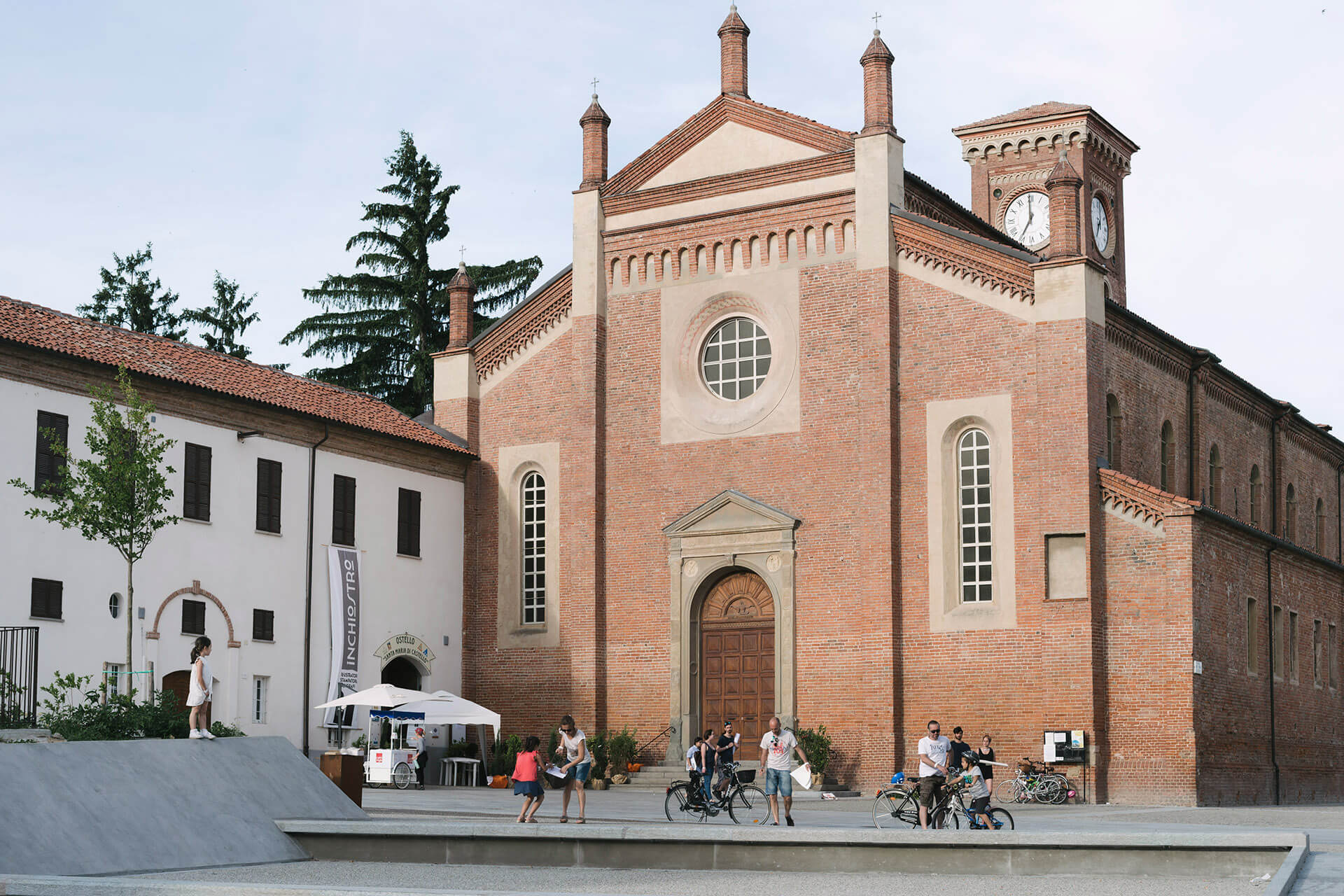 Santa Maria di Castelloanemptytextlline
Santa Maria di CastelloanemptytextllineThe church of Santa Maria di Castello, adjacent to the hostel, dates back, as it stands today, to the fifteenth century and blends in its structure styles of different epochs, such as the late Romanesque one of the building with the Renaissance portal and, inside, various works of later periods (the crucifix, the altar, the baptismal font, the sacristy). The church, elevated in 1629 to the status of abbey, was a parish church entrusted to the secular clergy. In 1805, during the French occupation, the monastery was transformed into a military warehouse. The building has a Romanesque-Gothic style and a Renaissance portal. The interior consists of three naves with cross vaults. The Church preserves a sixteenth-century sculpture representing the Deposition, made of polychrome terracotta, there is also a seventeenth-century wooden choir and a fourteenth-century tombstone belonging to Federico Dal Pozzo. The adjacent convent, where the hostel’s facilities are now located, is also very important, first entrusted to the Somaschi Fathers and then to the Sisters of Charity. In the Italian Risorgimento it was used as a barracks and hospital ward during epidemics in which contagious patients were isolated. Owned by the State Property, in 1866 it was partly used to house warehouses, prisons and guards. During the First World War it was used together with part of the church as a repository of the monopoly goods.
After the end of the Great War, the convent became the seat of the National Institute of War Orphans and later, entrusted to the Salesian nuns it hosted a school.
-
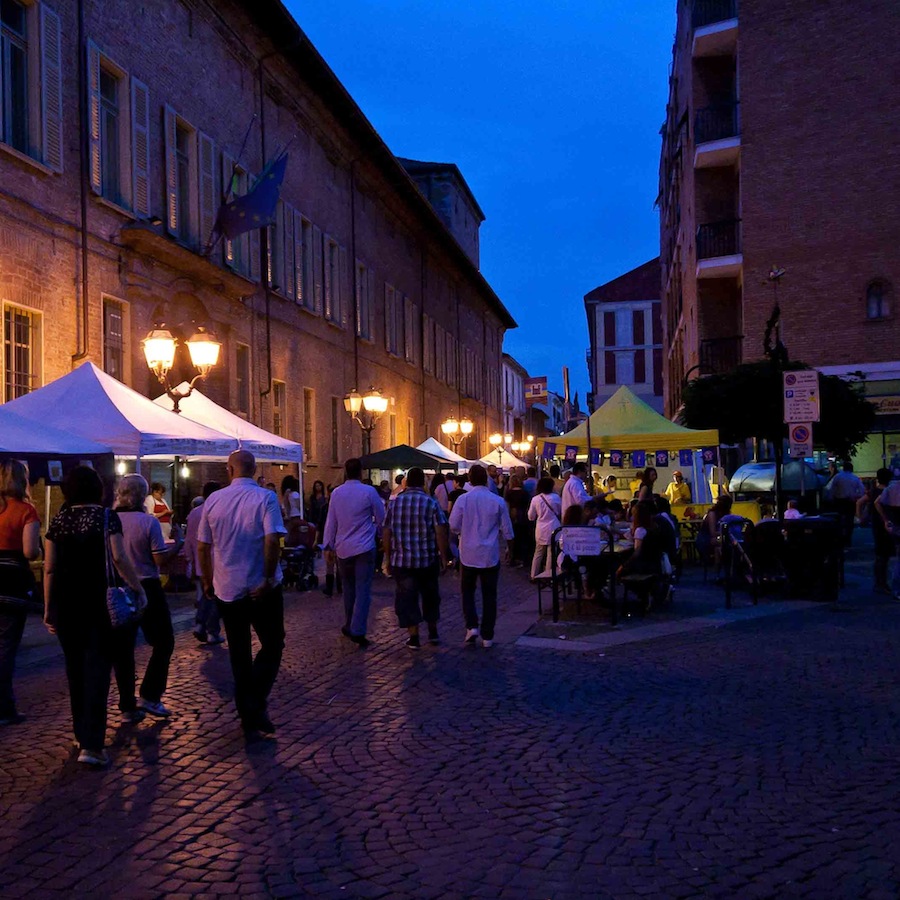 Borgo Roveretoanemptytextlline
Borgo RoveretoanemptytextllineBefore the birth of Alessandria, around Rovereto were centralized various villages among which Borgoglio and Bergoglio. The village of Rovereto (castrum roboreti) was surrounded by walls that protected the castle and the houses and was the typical medieval village. It seems that the name Rovereto comes from the numerous oak woods surrounding the village. Inside, the church of Santa Maria di Castello stood and still exists. In front of the castle of Rovereto, beyond the Tanaro river, where today we find the Citadel, there was an agricultural centre called Borgoglio, already connected with a bridge over the river, consolidated and made more stable in the past and recently demolished.
Rovereto had to be a warehouse for the goods that arrived from Genoa and were then directed to the neighbouring lands. Many inhabitants of the neighboring territories (Marengo, Villa del Foro, Solero, Oviglio, Quargnento, Borgoglio) saw so much traffic and money, they came to establish themselves in Rovereto that became a flourishing village and united against the arrogance of neighboring feudal lords. Thus, on May 3, 1168, the new town was born, and soon was named Alexandria in honor of Pope Alexander III. After the 1994 flood Borgo Rovereto is home to an important festival, held during a weekend in May, wanted by the inhabitants themselves as a symbol of the rebirth of the city; the courtyards of the ancient village open to host concerts, exhibitions, readings and the streets are filled with stands, teathers and musicians.
-
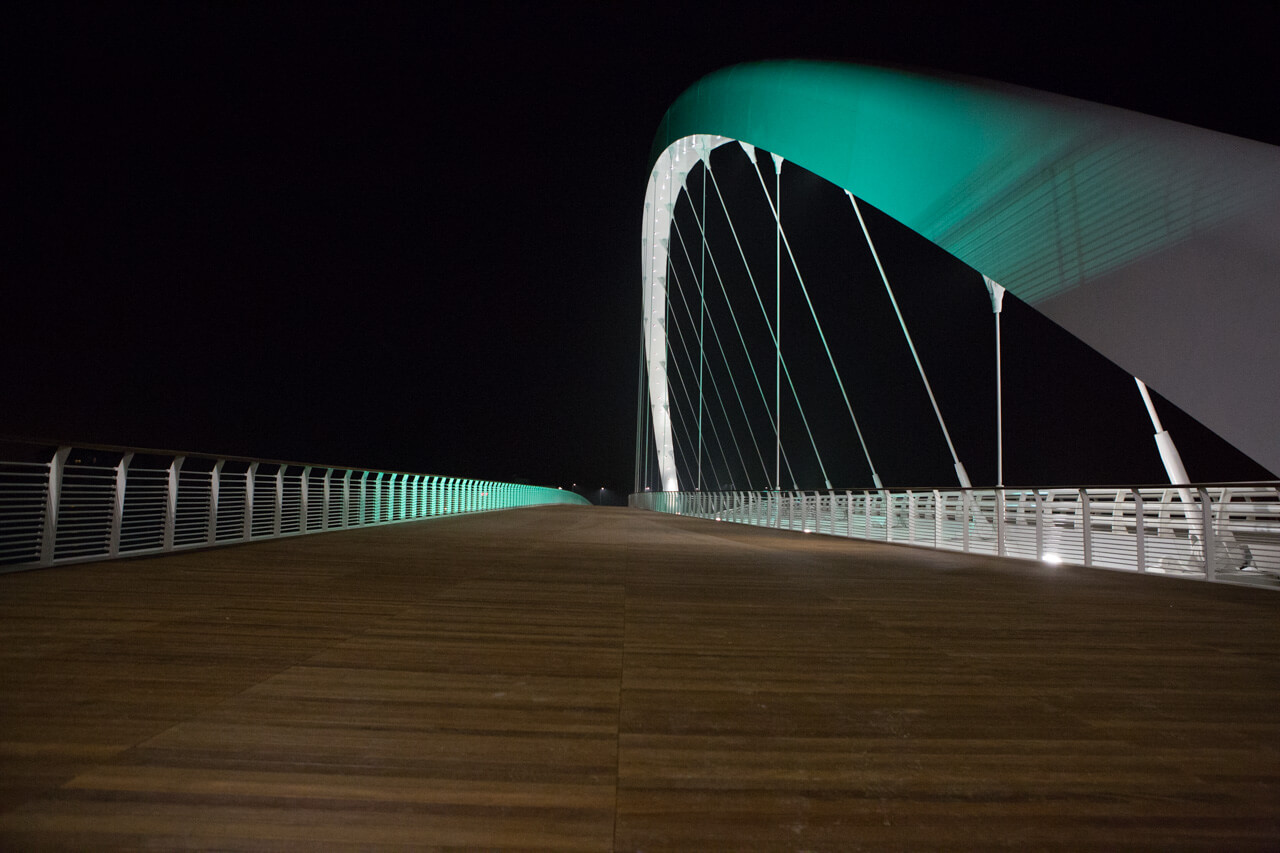 Meier's bridgeanemptytextlline
Meier's bridgeanemptytextllineThe new Cittadella bridge, designed by architect Richard Meier, is a bridge with a single span of 1767,121 meters composed by three main elements: arch, pedestrian platform and road platform. The two platforms are separated. These elements are curved around a central hollow space with an “almond shape” and interconnected through beams and steel cables forming the structural model. The 30-metre-high arch, approximately located along the central axis of the bridge, is the main load absorbing element and is tilted towards the pedestrian platform. The bridge separates vehicle traffic from pedestrian traffic. The roadway consists of three lanes and is 10.50 metres wide. The pedestrian platform follows the axis of the previous bridge, has a width that goes from 13 to 7 meters and is made with a wooden flooring. The central empty space, interconnected through cables and supports, is the main torsional element that bears the rotational effects caused by unbalanced platform loads. The frame is entirely made of steel.
-
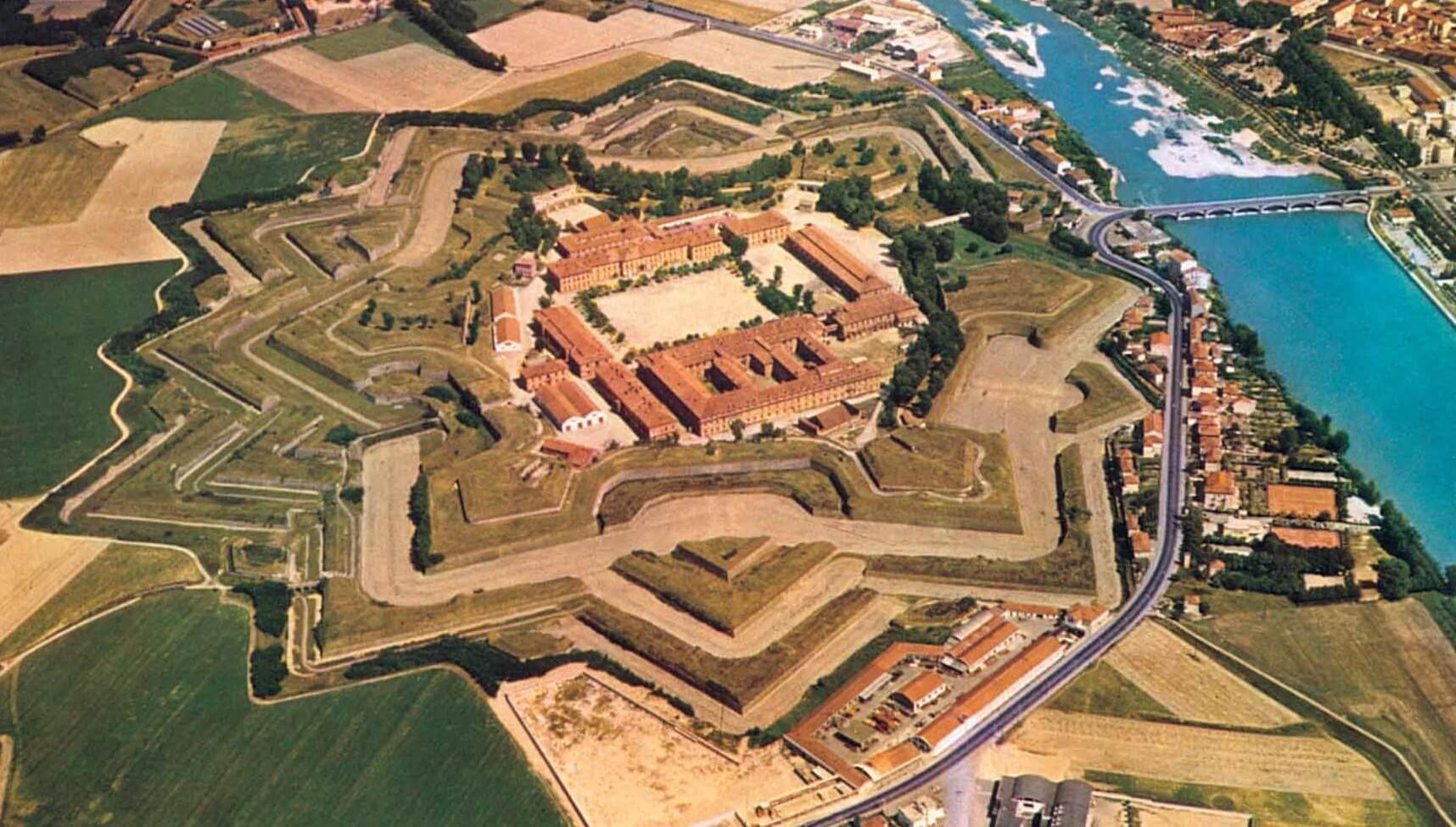 The Citadel of Alessandriaanemptytextlline
The Citadel of AlessandriaanemptytextllineThe Citadel of Alexandria is one of the most impressive European monuments in the context of the permanent fortification of the 18th century, one of the few still existing in Europe. It is the only European fortress still today in its original environmental context: there is no house screen that hides the view of the ramparts, or a long-distance road that surrounds the ditches. In 2014 EUROPA NOSTRA, with its prestigious programme “The 7 Most Endangered”, awarded the Citadel as one of the seven most endangered monuments in Europe.
-
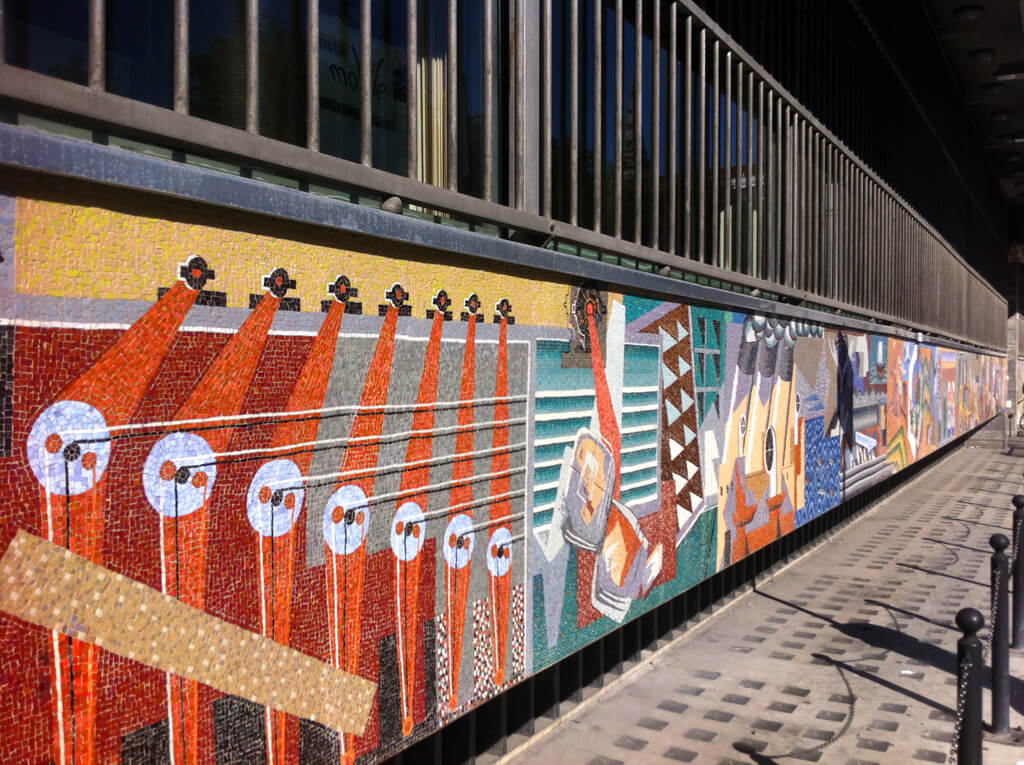 The Posts Palaceanemptytextlline
The Posts PalaceanemptytextllineThe Posts Palace of Alexandria is located in Piazza della Libertà. Built between 1939 and 1941 in a plainly rationalist style, it is decorated with a beautiful 38-metre long mosaic by Gino Severini, one of the greatest exponents of futurism, on the facade that represents the history of telecommunications.
-
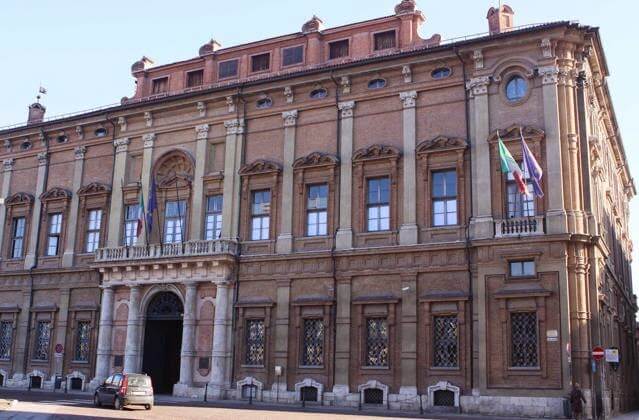 Palazzo Ghilinianemptytextlline
Palazzo GhilinianemptytextllinePalazzo Ghilini is an elegant palace in Piedmontese Baroque style of the city of Alessandria, one of the most monumental in its historic centre. It is the greatest Alexandrian monument “perhaps the most convincing city palace in the eighteenth century in Italy” (C. Norberg – Schulz, Late Baroque Architecture, Milan 1980, p. 137).
In 1869 the Provincial Council of Alexandria obtained the palace for the offices of the Province and Prefecture. -
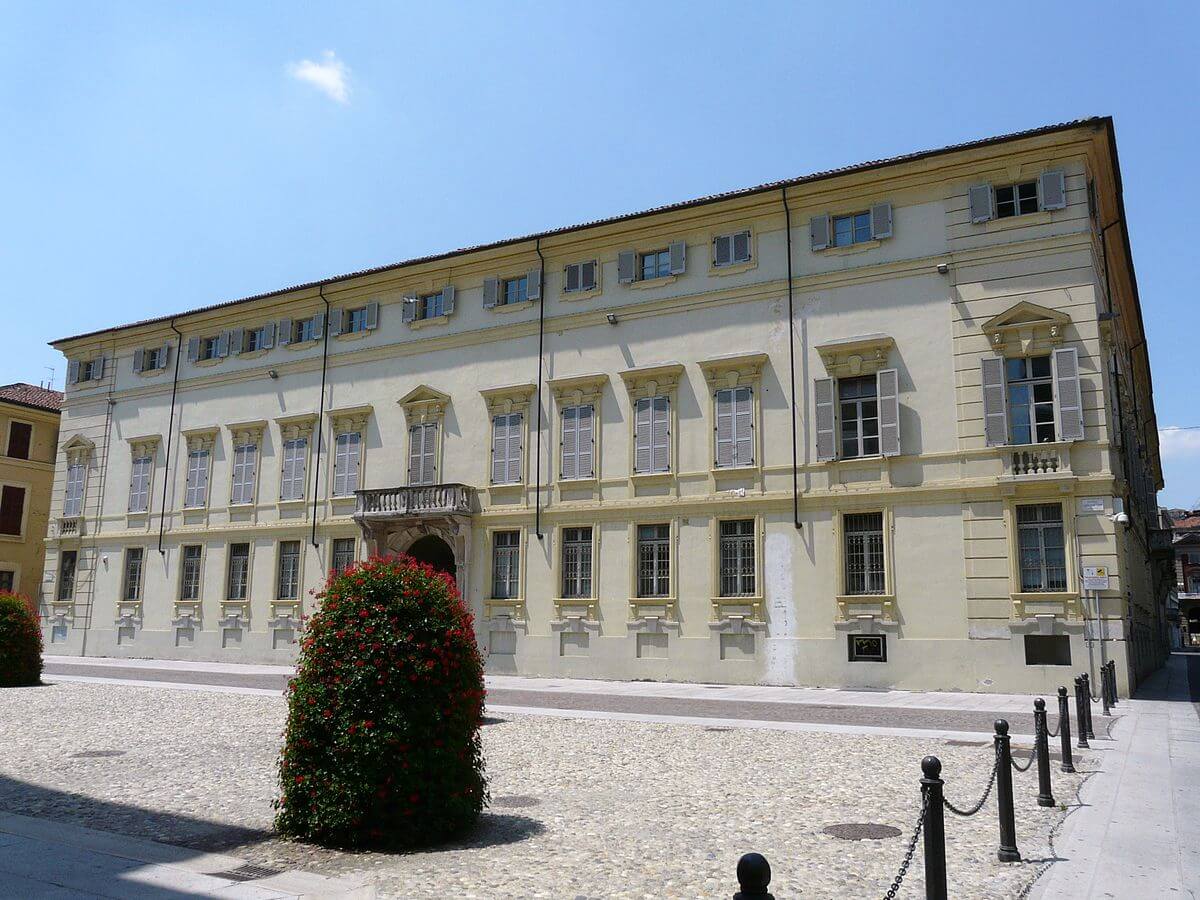 Palazzo Cuttica di Cassineanemptytextlline
Palazzo Cuttica di CassineanemptytextllinePalazzo Cuttica di Cassine is a palace of the city of Alessandria built in the eighteenth century by the Marquis Cuttica di Cassine and presents a style between Rococo and classicism. It quickly became a modern centre that welcomed the city’s best talents. Today the Palace houses the State Conservatory of Music “Antonio Vivaldi” and the adjoining secondary school.
-
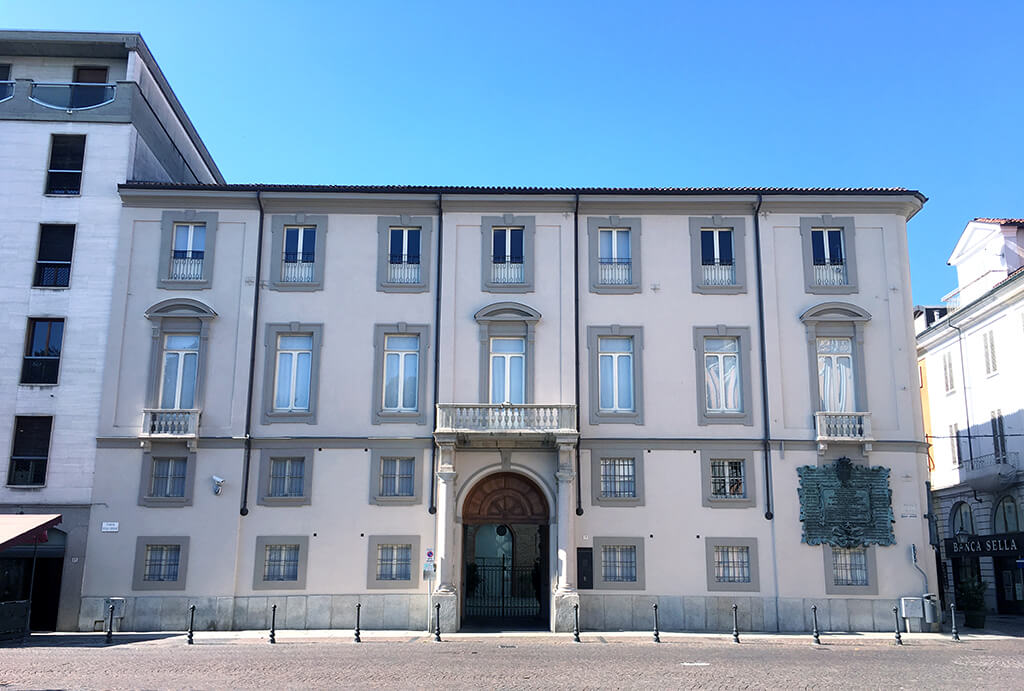 Palatium Vetusanemptytextlline
Palatium VetusanemptytextllinePalatium Vetus or Governor’s Palace, in the central Piazza della Libertà, was built around 1170. In the 13th and 14th centuries it was the centre of political, administrative and judicial life in the medieval town and known as “Broletto”. Recently renovated, it is now the seat of Fondazione Cassa di Risparmio di Alessandria and hosts temporary exhibitions.
-
 The Triumphal Archanemptytextlline
The Triumphal ArchanemptytextllineThe Triumphal Arch of Alexandria is an important monument of the city built in 1768, designed by Giuseppe Caselli, to commemorate the visit in 1765 of Vittorio Amedeo III and Maria Antonia Ferdinanda di Borbone, king and queen of the Kingdom of Sardinia. With a very light structure and no architectural functionality other than those related to the monumentality itself, the Arch has a diffused red colouration, with two orders, whose upper part houses the epigraph that recalls the visit to the city of the Savoy royal family.
-
 Santa Maria di Castelloanemptytextlline
Santa Maria di CastelloanemptytextllineThe church of Santa Maria di Castello, adjacent to the hostel, dates back, as it stands today, to the fifteenth century and blends in its structure styles of different epochs, such as the late Romanesque one of the building with the Renaissance portal and, inside, various works of later periods (the crucifix, the altar, the baptismal font, the sacristy). The church, elevated in 1629 to the status of abbey, was a parish church entrusted to the secular clergy. In 1805, during the French occupation, the monastery was transformed into a military warehouse. The building has a Romanesque-Gothic style and a Renaissance portal. The interior consists of three naves with cross vaults. The Church preserves a sixteenth-century sculpture representing the Deposition, made of polychrome terracotta, there is also a seventeenth-century wooden choir and a fourteenth-century tombstone belonging to Federico Dal Pozzo. The adjacent convent, where the hostel’s facilities are now located, is also very important, first entrusted to the Somaschi Fathers and then to the Sisters of Charity. In the Italian Risorgimento it was used as a barracks and hospital ward during epidemics in which contagious patients were isolated. Owned by the State Property, in 1866 it was partly used to house warehouses, prisons and guards. During the First World War it was used together with part of the church as a repository of the monopoly goods.
After the end of the Great War, the convent became the seat of the National Institute of War Orphans and later, entrusted to the Salesian nuns it hosted a school.
-
 Borgo Roveretoanemptytextlline
Borgo RoveretoanemptytextllineBefore the birth of Alessandria, around Rovereto were centralized various villages among which Borgoglio and Bergoglio. The village of Rovereto (castrum roboreti) was surrounded by walls that protected the castle and the houses and was the typical medieval village. It seems that the name Rovereto comes from the numerous oak woods surrounding the village. Inside, the church of Santa Maria di Castello stood and still exists. In front of the castle of Rovereto, beyond the Tanaro river, where today we find the Citadel, there was an agricultural centre called Borgoglio, already connected with a bridge over the river, consolidated and made more stable in the past and recently demolished.
Rovereto had to be a warehouse for the goods that arrived from Genoa and were then directed to the neighbouring lands. Many inhabitants of the neighboring territories (Marengo, Villa del Foro, Solero, Oviglio, Quargnento, Borgoglio) saw so much traffic and money, they came to establish themselves in Rovereto that became a flourishing village and united against the arrogance of neighboring feudal lords. Thus, on May 3, 1168, the new town was born, and soon was named Alexandria in honor of Pope Alexander III. After the 1994 flood Borgo Rovereto is home to an important festival, held during a weekend in May, wanted by the inhabitants themselves as a symbol of the rebirth of the city; the courtyards of the ancient village open to host concerts, exhibitions, readings and the streets are filled with stands, teathers and musicians.
-
 Meier's bridgeanemptytextlline
Meier's bridgeanemptytextllineThe new Cittadella bridge, designed by architect Richard Meier, is a bridge with a single span of 1767,121 meters composed by three main elements: arch, pedestrian platform and road platform. The two platforms are separated. These elements are curved around a central hollow space with an “almond shape” and interconnected through beams and steel cables forming the structural model. The 30-metre-high arch, approximately located along the central axis of the bridge, is the main load absorbing element and is tilted towards the pedestrian platform. The bridge separates vehicle traffic from pedestrian traffic. The roadway consists of three lanes and is 10.50 metres wide. The pedestrian platform follows the axis of the previous bridge, has a width that goes from 13 to 7 meters and is made with a wooden flooring. The central empty space, interconnected through cables and supports, is the main torsional element that bears the rotational effects caused by unbalanced platform loads. The frame is entirely made of steel.
-
 The Citadel of Alessandriaanemptytextlline
The Citadel of AlessandriaanemptytextllineThe Citadel of Alexandria is one of the most impressive European monuments in the context of the permanent fortification of the 18th century, one of the few still existing in Europe. It is the only European fortress still today in its original environmental context: there is no house screen that hides the view of the ramparts, or a long-distance road that surrounds the ditches. In 2014 EUROPA NOSTRA, with its prestigious programme “The 7 Most Endangered”, awarded the Citadel as one of the seven most endangered monuments in Europe.
-
 The Posts Palaceanemptytextlline
The Posts PalaceanemptytextllineThe Posts Palace of Alexandria is located in Piazza della Libertà. Built between 1939 and 1941 in a plainly rationalist style, it is decorated with a beautiful 38-metre long mosaic by Gino Severini, one of the greatest exponents of futurism, on the facade that represents the history of telecommunications.
-
 Palazzo Ghilinianemptytextlline
Palazzo GhilinianemptytextllinePalazzo Ghilini is an elegant palace in Piedmontese Baroque style of the city of Alessandria, one of the most monumental in its historic centre. It is the greatest Alexandrian monument “perhaps the most convincing city palace in the eighteenth century in Italy” (C. Norberg – Schulz, Late Baroque Architecture, Milan 1980, p. 137).
In 1869 the Provincial Council of Alexandria obtained the palace for the offices of the Province and Prefecture. -
 Palazzo Cuttica di Cassineanemptytextlline
Palazzo Cuttica di CassineanemptytextllinePalazzo Cuttica di Cassine is a palace of the city of Alessandria built in the eighteenth century by the Marquis Cuttica di Cassine and presents a style between Rococo and classicism. It quickly became a modern centre that welcomed the city’s best talents. Today the Palace houses the State Conservatory of Music “Antonio Vivaldi” and the adjoining secondary school.
-
 Palatium Vetusanemptytextlline
Palatium VetusanemptytextllinePalatium Vetus or Governor’s Palace, in the central Piazza della Libertà, was built around 1170. In the 13th and 14th centuries it was the centre of political, administrative and judicial life in the medieval town and known as “Broletto”. Recently renovated, it is now the seat of Fondazione Cassa di Risparmio di Alessandria and hosts temporary exhibitions.
-
 The Triumphal Archanemptytextlline
The Triumphal ArchanemptytextllineThe Triumphal Arch of Alexandria is an important monument of the city built in 1768, designed by Giuseppe Caselli, to commemorate the visit in 1765 of Vittorio Amedeo III and Maria Antonia Ferdinanda di Borbone, king and queen of the Kingdom of Sardinia. With a very light structure and no architectural functionality other than those related to the monumentality itself, the Arch has a diffused red colouration, with two orders, whose upper part houses the epigraph that recalls the visit to the city of the Savoy royal family.
-
 Santa Maria di Castelloanemptytextlline
Santa Maria di CastelloanemptytextllineThe church of Santa Maria di Castello, adjacent to the hostel, dates back, as it stands today, to the fifteenth century and blends in its structure styles of different epochs, such as the late Romanesque one of the building with the Renaissance portal and, inside, various works of later periods (the crucifix, the altar, the baptismal font, the sacristy). The church, elevated in 1629 to the status of abbey, was a parish church entrusted to the secular clergy. In 1805, during the French occupation, the monastery was transformed into a military warehouse. The building has a Romanesque-Gothic style and a Renaissance portal. The interior consists of three naves with cross vaults. The Church preserves a sixteenth-century sculpture representing the Deposition, made of polychrome terracotta, there is also a seventeenth-century wooden choir and a fourteenth-century tombstone belonging to Federico Dal Pozzo. The adjacent convent, where the hostel’s facilities are now located, is also very important, first entrusted to the Somaschi Fathers and then to the Sisters of Charity. In the Italian Risorgimento it was used as a barracks and hospital ward during epidemics in which contagious patients were isolated. Owned by the State Property, in 1866 it was partly used to house warehouses, prisons and guards. During the First World War it was used together with part of the church as a repository of the monopoly goods.
After the end of the Great War, the convent became the seat of the National Institute of War Orphans and later, entrusted to the Salesian nuns it hosted a school.
-
 Borgo Roveretoanemptytextlline
Borgo RoveretoanemptytextllineBefore the birth of Alessandria, around Rovereto were centralized various villages among which Borgoglio and Bergoglio. The village of Rovereto (castrum roboreti) was surrounded by walls that protected the castle and the houses and was the typical medieval village. It seems that the name Rovereto comes from the numerous oak woods surrounding the village. Inside, the church of Santa Maria di Castello stood and still exists. In front of the castle of Rovereto, beyond the Tanaro river, where today we find the Citadel, there was an agricultural centre called Borgoglio, already connected with a bridge over the river, consolidated and made more stable in the past and recently demolished.
Rovereto had to be a warehouse for the goods that arrived from Genoa and were then directed to the neighbouring lands. Many inhabitants of the neighboring territories (Marengo, Villa del Foro, Solero, Oviglio, Quargnento, Borgoglio) saw so much traffic and money, they came to establish themselves in Rovereto that became a flourishing village and united against the arrogance of neighboring feudal lords. Thus, on May 3, 1168, the new town was born, and soon was named Alexandria in honor of Pope Alexander III. After the 1994 flood Borgo Rovereto is home to an important festival, held during a weekend in May, wanted by the inhabitants themselves as a symbol of the rebirth of the city; the courtyards of the ancient village open to host concerts, exhibitions, readings and the streets are filled with stands, teathers and musicians.
-
 Meier's bridgeanemptytextlline
Meier's bridgeanemptytextllineThe new Cittadella bridge, designed by architect Richard Meier, is a bridge with a single span of 1767,121 meters composed by three main elements: arch, pedestrian platform and road platform. The two platforms are separated. These elements are curved around a central hollow space with an “almond shape” and interconnected through beams and steel cables forming the structural model. The 30-metre-high arch, approximately located along the central axis of the bridge, is the main load absorbing element and is tilted towards the pedestrian platform. The bridge separates vehicle traffic from pedestrian traffic. The roadway consists of three lanes and is 10.50 metres wide. The pedestrian platform follows the axis of the previous bridge, has a width that goes from 13 to 7 meters and is made with a wooden flooring. The central empty space, interconnected through cables and supports, is the main torsional element that bears the rotational effects caused by unbalanced platform loads. The frame is entirely made of steel.
-
 The Citadel of Alessandriaanemptytextlline
The Citadel of AlessandriaanemptytextllineThe Citadel of Alexandria is one of the most impressive European monuments in the context of the permanent fortification of the 18th century, one of the few still existing in Europe. It is the only European fortress still today in its original environmental context: there is no house screen that hides the view of the ramparts, or a long-distance road that surrounds the ditches. In 2014 EUROPA NOSTRA, with its prestigious programme “The 7 Most Endangered”, awarded the Citadel as one of the seven most endangered monuments in Europe.
-
 The Posts Palaceanemptytextlline
The Posts PalaceanemptytextllineThe Posts Palace of Alexandria is located in Piazza della Libertà. Built between 1939 and 1941 in a plainly rationalist style, it is decorated with a beautiful 38-metre long mosaic by Gino Severini, one of the greatest exponents of futurism, on the facade that represents the history of telecommunications.
-
 Palazzo Ghilinianemptytextlline
Palazzo GhilinianemptytextllinePalazzo Ghilini is an elegant palace in Piedmontese Baroque style of the city of Alessandria, one of the most monumental in its historic centre. It is the greatest Alexandrian monument “perhaps the most convincing city palace in the eighteenth century in Italy” (C. Norberg – Schulz, Late Baroque Architecture, Milan 1980, p. 137).
In 1869 the Provincial Council of Alexandria obtained the palace for the offices of the Province and Prefecture. -
 Palazzo Cuttica di Cassineanemptytextlline
Palazzo Cuttica di CassineanemptytextllinePalazzo Cuttica di Cassine is a palace of the city of Alessandria built in the eighteenth century by the Marquis Cuttica di Cassine and presents a style between Rococo and classicism. It quickly became a modern centre that welcomed the city’s best talents. Today the Palace houses the State Conservatory of Music “Antonio Vivaldi” and the adjoining secondary school.
-
 Palatium Vetusanemptytextlline
Palatium VetusanemptytextllinePalatium Vetus or Governor’s Palace, in the central Piazza della Libertà, was built around 1170. In the 13th and 14th centuries it was the centre of political, administrative and judicial life in the medieval town and known as “Broletto”. Recently renovated, it is now the seat of Fondazione Cassa di Risparmio di Alessandria and hosts temporary exhibitions.
-
 The Triumphal Archanemptytextlline
The Triumphal ArchanemptytextllineThe Triumphal Arch of Alexandria is an important monument of the city built in 1768, designed by Giuseppe Caselli, to commemorate the visit in 1765 of Vittorio Amedeo III and Maria Antonia Ferdinanda di Borbone, king and queen of the Kingdom of Sardinia. With a very light structure and no architectural functionality other than those related to the monumentality itself, the Arch has a diffused red colouration, with two orders, whose upper part houses the epigraph that recalls the visit to the city of the Savoy royal family.
-
 Santa Maria di Castelloanemptytextlline
Santa Maria di CastelloanemptytextllineThe church of Santa Maria di Castello, adjacent to the hostel, dates back, as it stands today, to the fifteenth century and blends in its structure styles of different epochs, such as the late Romanesque one of the building with the Renaissance portal and, inside, various works of later periods (the crucifix, the altar, the baptismal font, the sacristy). The church, elevated in 1629 to the status of abbey, was a parish church entrusted to the secular clergy. In 1805, during the French occupation, the monastery was transformed into a military warehouse. The building has a Romanesque-Gothic style and a Renaissance portal. The interior consists of three naves with cross vaults. The Church preserves a sixteenth-century sculpture representing the Deposition, made of polychrome terracotta, there is also a seventeenth-century wooden choir and a fourteenth-century tombstone belonging to Federico Dal Pozzo. The adjacent convent, where the hostel’s facilities are now located, is also very important, first entrusted to the Somaschi Fathers and then to the Sisters of Charity. In the Italian Risorgimento it was used as a barracks and hospital ward during epidemics in which contagious patients were isolated. Owned by the State Property, in 1866 it was partly used to house warehouses, prisons and guards. During the First World War it was used together with part of the church as a repository of the monopoly goods.
After the end of the Great War, the convent became the seat of the National Institute of War Orphans and later, entrusted to the Salesian nuns it hosted a school.
-
 Borgo Roveretoanemptytextlline
Borgo RoveretoanemptytextllineBefore the birth of Alessandria, around Rovereto were centralized various villages among which Borgoglio and Bergoglio. The village of Rovereto (castrum roboreti) was surrounded by walls that protected the castle and the houses and was the typical medieval village. It seems that the name Rovereto comes from the numerous oak woods surrounding the village. Inside, the church of Santa Maria di Castello stood and still exists. In front of the castle of Rovereto, beyond the Tanaro river, where today we find the Citadel, there was an agricultural centre called Borgoglio, already connected with a bridge over the river, consolidated and made more stable in the past and recently demolished.
Rovereto had to be a warehouse for the goods that arrived from Genoa and were then directed to the neighbouring lands. Many inhabitants of the neighboring territories (Marengo, Villa del Foro, Solero, Oviglio, Quargnento, Borgoglio) saw so much traffic and money, they came to establish themselves in Rovereto that became a flourishing village and united against the arrogance of neighboring feudal lords. Thus, on May 3, 1168, the new town was born, and soon was named Alexandria in honor of Pope Alexander III. After the 1994 flood Borgo Rovereto is home to an important festival, held during a weekend in May, wanted by the inhabitants themselves as a symbol of the rebirth of the city; the courtyards of the ancient village open to host concerts, exhibitions, readings and the streets are filled with stands, teathers and musicians.
-
 Meier's bridgeanemptytextlline
Meier's bridgeanemptytextllineThe new Cittadella bridge, designed by architect Richard Meier, is a bridge with a single span of 1767,121 meters composed by three main elements: arch, pedestrian platform and road platform. The two platforms are separated. These elements are curved around a central hollow space with an “almond shape” and interconnected through beams and steel cables forming the structural model. The 30-metre-high arch, approximately located along the central axis of the bridge, is the main load absorbing element and is tilted towards the pedestrian platform. The bridge separates vehicle traffic from pedestrian traffic. The roadway consists of three lanes and is 10.50 metres wide. The pedestrian platform follows the axis of the previous bridge, has a width that goes from 13 to 7 meters and is made with a wooden flooring. The central empty space, interconnected through cables and supports, is the main torsional element that bears the rotational effects caused by unbalanced platform loads. The frame is entirely made of steel.
-
 The Citadel of Alessandriaanemptytextlline
The Citadel of AlessandriaanemptytextllineThe Citadel of Alexandria is one of the most impressive European monuments in the context of the permanent fortification of the 18th century, one of the few still existing in Europe. It is the only European fortress still today in its original environmental context: there is no house screen that hides the view of the ramparts, or a long-distance road that surrounds the ditches. In 2014 EUROPA NOSTRA, with its prestigious programme “The 7 Most Endangered”, awarded the Citadel as one of the seven most endangered monuments in Europe.
-
 The Posts Palaceanemptytextlline
The Posts PalaceanemptytextllineThe Posts Palace of Alexandria is located in Piazza della Libertà. Built between 1939 and 1941 in a plainly rationalist style, it is decorated with a beautiful 38-metre long mosaic by Gino Severini, one of the greatest exponents of futurism, on the facade that represents the history of telecommunications.
-
 Palazzo Ghilinianemptytextlline
Palazzo GhilinianemptytextllinePalazzo Ghilini is an elegant palace in Piedmontese Baroque style of the city of Alessandria, one of the most monumental in its historic centre. It is the greatest Alexandrian monument “perhaps the most convincing city palace in the eighteenth century in Italy” (C. Norberg – Schulz, Late Baroque Architecture, Milan 1980, p. 137).
In 1869 the Provincial Council of Alexandria obtained the palace for the offices of the Province and Prefecture. -
 Palazzo Cuttica di Cassineanemptytextlline
Palazzo Cuttica di CassineanemptytextllinePalazzo Cuttica di Cassine is a palace of the city of Alessandria built in the eighteenth century by the Marquis Cuttica di Cassine and presents a style between Rococo and classicism. It quickly became a modern centre that welcomed the city’s best talents. Today the Palace houses the State Conservatory of Music “Antonio Vivaldi” and the adjoining secondary school.
-
 Palatium Vetusanemptytextlline
Palatium VetusanemptytextllinePalatium Vetus or Governor’s Palace, in the central Piazza della Libertà, was built around 1170. In the 13th and 14th centuries it was the centre of political, administrative and judicial life in the medieval town and known as “Broletto”. Recently renovated, it is now the seat of Fondazione Cassa di Risparmio di Alessandria and hosts temporary exhibitions.
-
 The Triumphal Archanemptytextlline
The Triumphal ArchanemptytextllineThe Triumphal Arch of Alexandria is an important monument of the city built in 1768, designed by Giuseppe Caselli, to commemorate the visit in 1765 of Vittorio Amedeo III and Maria Antonia Ferdinanda di Borbone, king and queen of the Kingdom of Sardinia. With a very light structure and no architectural functionality other than those related to the monumentality itself, the Arch has a diffused red colouration, with two orders, whose upper part houses the epigraph that recalls the visit to the city of the Savoy royal family.
